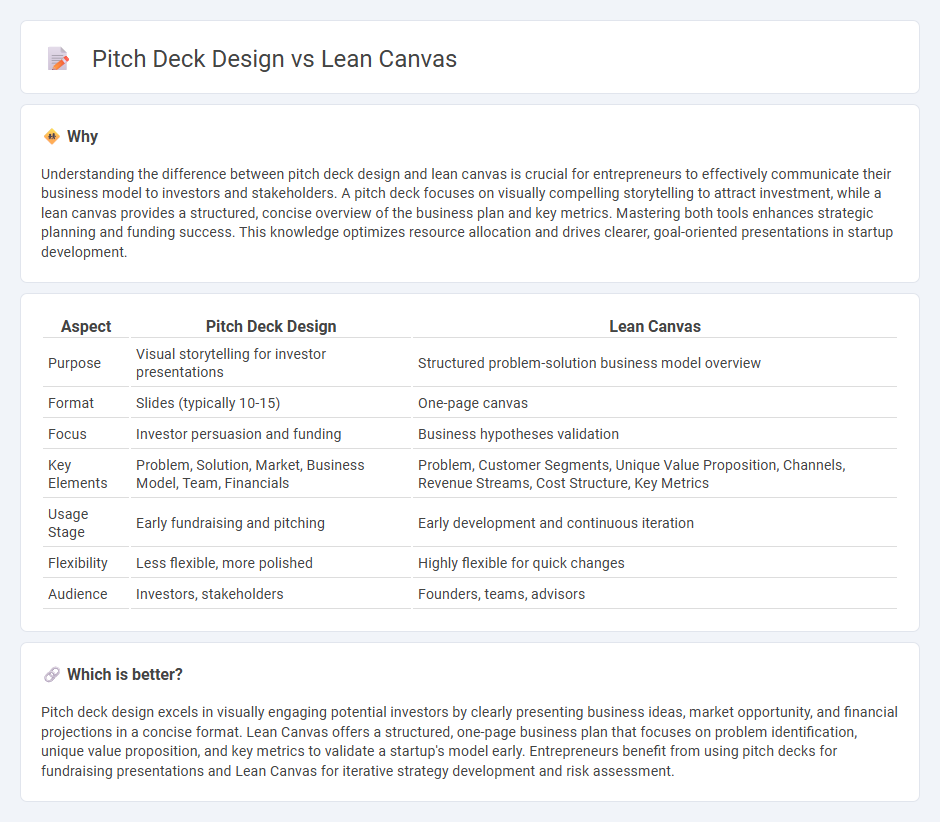
Pitch deck design visually communicates a startup's business model, market opportunity, and financial projections to attract investors, emphasizing clear graphics and storytelling. Lean Canvas offers a structured one-page framework that captures key business elements like problems, solutions, key metrics, and unique value proposition, enabling quick iterative validation. Explore how choosing the right tool can accelerate startup funding and strategic clarity.
Why it is important
Understanding the difference between pitch deck design and lean canvas is crucial for entrepreneurs to effectively communicate their business model to investors and stakeholders. A pitch deck focuses on visually compelling storytelling to attract investment, while a lean canvas provides a structured, concise overview of the business plan and key metrics. Mastering both tools enhances strategic planning and funding success. This knowledge optimizes resource allocation and drives clearer, goal-oriented presentations in startup development.
Comparison Table
| Aspect | Pitch Deck Design | Lean Canvas |
|---|---|---|
| Purpose | Visual storytelling for investor presentations | Structured problem-solution business model overview |
| Format | Slides (typically 10-15) | One-page canvas |
| Focus | Investor persuasion and funding | Business hypotheses validation |
| Key Elements | Problem, Solution, Market, Business Model, Team, Financials | Problem, Customer Segments, Unique Value Proposition, Channels, Revenue Streams, Cost Structure, Key Metrics |
| Usage Stage | Early fundraising and pitching | Early development and continuous iteration |
| Flexibility | Less flexible, more polished | Highly flexible for quick changes |
| Audience | Investors, stakeholders | Founders, teams, advisors |
Which is better?
Pitch deck design excels in visually engaging potential investors by clearly presenting business ideas, market opportunity, and financial projections in a concise format. Lean Canvas offers a structured, one-page business plan that focuses on problem identification, unique value proposition, and key metrics to validate a startup's model early. Entrepreneurs benefit from using pitch decks for fundraising presentations and Lean Canvas for iterative strategy development and risk assessment.
Connection
Pitch deck design and Lean Canvas are interconnected tools in entrepreneurship that facilitate clear communication of a startup's value proposition, business model, and market strategy. A well-crafted pitch deck visually summarizes the key elements outlined in the Lean Canvas, such as customer segments, problem definition, unique value proposition, channels, revenue streams, and cost structure. Entrepreneurs leverage both frameworks to attract investors by streamlining the articulation of business hypotheses and strategic plans, fostering informed decision-making and funding opportunities.
Key Terms
Problem-Solution Fit
Lean Canvas emphasizes identifying and validating the Problem-Solution Fit by mapping out customer problems, possible solutions, key metrics, and unique value propositions in a concise, single-page format. Pitch decks prioritize storytelling with visually engaging slides that highlight the problem, solution, market opportunity, business model, and team to attract investors. Explore detailed comparisons and best practices to master both tools for startup success.
Value Proposition
The Value Proposition is central to both Lean Canvas and pitch deck design, serving as the core message that communicates the unique benefits a product or service offers. Lean Canvas emphasizes a concise, problem-solution framework that highlights customer needs and how the offering addresses them, streamlining strategic planning. Explore how to craft compelling Value Propositions for effective Lean Canvas and pitch deck presentations.
Key Metrics
Lean Canvas emphasizes identifying and tracking Key Metrics that directly measure business progress and validate assumptions, often focusing on actionable data like customer acquisition cost and lifetime value. Pitch Deck design highlights Key Metrics to impress investors by showcasing traction through concise, visually appealing charts and comparison with industry benchmarks. Discover how to optimize Key Metrics representation to effectively convey your startup's growth potential.
Source and External Links
Lean Canvas Examples of Multi-Billion Startups - Railsware - Lean Canvas, created by Ash Maurya as an adaptation of the Business Model Canvas, uses a problem-solution approach tailored for startups to rapidly transform ideas into products while focusing on customer needs and actionable metrics.
What is a Lean Canvas? (Examples and Tips) - Canva - Lean Canvas is a concise, one-page diagram designed for entrepreneurs to develop, evaluate, and validate startup ideas, emphasizing problem-solving and learning early to reduce the risk of building the wrong product.
Lean Canvas - BM Toolbox - Lean Canvas focuses on nine key components like Problem, Solution, Key Metrics, and Unfair Advantage, integrating the lean startup methodology (build-measure-learn) to help entrepreneurs quickly sketch and test business ideas with a focus on one customer segment per canvas.
 dowidth.com
dowidth.com